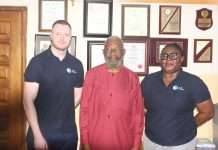By Pharm. Nelson Okwonna
NIPRISAN, more popularly or formally known as NICOSAN™, is a herbal formulation for the management of sickle-cell disease(SCD) developed by indigenous researchers at the National Institute for Pharmaceutical Research and Development (NIPRD), Abuja, Nigeria. NIPRISAN, as claimed in the patent, is a herbal mixture extract, formulated from parts of four different indigenous plants (Piper guineenses seeds, Pterocarpus osun stem, Eugenia caryophylum fruit and Sorghum bicolor leaves) and an inorganic material mixed at specific ratios which has been shown to be safe and effective in the management of sickle cell disease during a phase 1 and subsequent Phase 2 clinical trials.
In his article: “NIPRISAN Case, Nigeria: A Report for GenBenefit” published in 2007. Professor C. Wambebe described the events that led to the development of the therapy for sickle cell disease by indigenous researchers. Under his leadership as the Chief Executive officer, the management at the National Institute for Pharmaceutical Research and Development (NIPRD) had focused on indigenous medical knowledge in their search for a therapy for SCD.
They had received credible information about Rev. Ogunyale who was treating SCD patients with a herbal medicine. Rev. Ogunyale was then invited to discuss possible collaboration with the NIPRD. After some negotiations, he released his recipe, as a sacred trust, for further development into an effective medicine for the benefit of SCD patients globally.
According to Article 27 of Trade Related Aspects of Intellectual Property Rights (TRIPS) Agreement, patents can be granted in all fields of technology vis-à-vis processes and products with the exclusion of plants and animals. However, the caveat that natural substances do not qualify for patentability applies directly to plants, animals and micro-organisms, it does not infer that the technical processes applied to develop a product with a potential for future commercialisation for specific public use cannot be patented. The patenting of NIPRISAN in the USAwas undertaken under this premise.
Considering the amount of time and money spent in obtaining a patent, the effort should be worth it. A patent should have economic value to the holder and the process for actualising the economic value for a patent should be well considered before the patent is filed. For instance, it could be wise to delay filing a patent for a drug molecule if it would take another ten years to get to the market, as the market exclusivity provided by a patent is usually between fourteen and twenty years from the date of filing.
The risk of exposure prior to filing should be weighed against the time advantage of a delayed filing. Copying and adding a slight modification in the nature of an existing patented material could justify obtaining a new patent for the modified material. This could be an effective business strategy. Another strategy is to wait and copy! Waiting for a patent to expire and then reproducing the product or process is a good means of developing generic drugs.
A proper intellectual property protection infrastructure assures the knowledge workers that they would reap maximum benefits from their creations.
LICENSING
A patent, trademark or copyright can be licensed to a second party other than the assignee. In the case study, Xechem Pharmaceutical Nigeria Ltd was the licensee responsible for the further development and marketing of NIPRISAN. The product was marketed as NICOSAN™ Licensing allows the holder of the proprietary rights to leverage on the finances of other parties. As shown in this story, the product was licensed to Xechem who were able to raise the financing for further development and had the capacity to commercialize the venture.
A licensing agreement usually grants the licensee the rights to use, make, manufacture and sell products under the rights granted by the licensor in a given territory. These rights granted by the licensor to the licensee can be sole, exclusive and non-exclusive.The licence issued to Xechem in this case study was an exclusive license. A patent does not confer marketing rights for certain regulated products like drugs, food and certain technology. These would still need to be approved by certain regulatory agencies before they can be used in a particular country. NICOSAN™ was approved for marketing by the National Agency for Food and Drug Administration and Control (NAFDAC).
INDUSTRY PARTNERSHIP
A patent does not automatically imply resource generation. There should be an effective strategy for converting the invention to money. The strategy should be one that yields sufficient returns on the investment before the market exclusivity expires and “generics” begin to flood the market. Collaboration is therefore a necessity. There is a big difference between the language of research and that of commerce, and a bridge is necessary to translate the products of research to useful products on the shelf. As shown by the Honourable Minister, Prof. Turner Isoun in our story above, that bridge is arrived at via conscious, deliberate efforts.
The first deliberate effort is to develop products of research with economic potentials. The next deliberate step is to achieve intellectual property protection. Intellectual property protection assures market exclusivity and justifies the partnership with the industry which is in desperate need of the rewards of such market exclusivity. Leadership in research implies understanding the limitations of a solo effort and hence the need for collaboration amongst researchers, development consultants and industry. A research development consultant could be needed to design and implement a mutually profitable strategic framework for partnering with the industry. This ensures that the often eccentric academic researcher is not exploited by the perceived “sharks” in the industry.
Once an interested party is identified and talks begin, there are a number of options that might be selected to develop the product.
- The research team could develop a company, raise money and build a business around their product: Examples are Google, Research in Motion, Apple Computers, and even the numerous companies that Thomas Edison founded to produce his inventions. To achieve success, however, the research team should have the necessary managerial competence. If need be, the researcher or research team could offer ownership for managerial competence. This was how Bill Gates got Steve Ballmer to join Microsoft.The process of finding such funding is either from personal savings, loans, profits from the business, venture financing or public offers.
- Secure a royalty agreement by licensing the product to a second party as was done with
NIPRISAN.The following are the payment options under a Licence agreement:
a) Lump sum fee
b) Percentage of net sales
c) Percentage of profit before tax
d) Combination of lump sum fee and a percentage of net sales
e) Combination of a percentage of net sales and a percentage of net profit before tax
The NIPRD-Xechem collaboration was for a good faith payment of $115,000 and a 7.5 per cent of gross sales as royalties.
The first option has always been shown to be more profitable especially in our time and age. A challenge, however, occurs when the competition is such that the new small company is unable to compete fairly in the market.
Assuming you are to develop a much better mobile technology, as was the case with the development of the Blackberry device by Research in Motion Inc., the size of the competition is enormous. To compete, the new firm should have fairly large financial muscles in addition to her intellectual property protection. To achieve this, she might need to leverage on the partnership of individuals or organisations with some very deep pockets or partner with one of the existing large firms. The strategy for making such an entry is often as much or sometimes even more important than the innovation itself. Most of the time, these new firms resort to venture financing and then subsequent initial public offer on the stock market – Research in Motion Inc. took this path.
Reference
- Okwonna, N. (2012). The Heart and Art of Innovation, Onel Media Services, Lagos, Nigeria











generic tadalafil united states: http://tadalafilonline20.com/ tadalafil 60 mg for sale
I just want to ask if Niprisan is now available in the market now? which pharmaceutical shop can I get in Lagos or Ogun and how much does it cost?
Helpful information. Fortunate me I discovered your web site by chance, and I am shocked why this accident did not
happened earlier! I bookmarked it.
Hello! I’m at work surfing around your blog from
my new apple iphone! Just wanted to say I love reading your
blog and look forward to all your posts! Keep up the excellent work!
Here is my site :: google